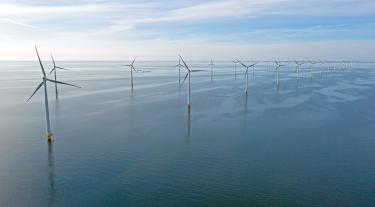The Integrator programme has secured support from six major offshore wind farm developers to undertake four ground-breaking research projects this year as part of its second phase of operation. Following its initial year, this developer-led programme, supported by EnBW, Equinor, ScottishPower Renewables, SSE Renewables, TotalEnergies and Vattenfall, continues to focus on the opportunities to overcome system integration challenges with a particular focus on hydrogen and system services.
The programme is now tendering the following four projects:
Hydrogen Production from Offshore Wind
Whilst offshore hydrogen production technologies are being developed and piloted, there are still knowledge gaps about the technical feasibility of different green hydrogen production configurations and the whole life cycle cost of managing green hydrogen production facilities.
This project will undertake a technical review of the technologies relevant to large-scale green hydrogen production. It will then develop scenarios for hydrogen production, both on and offshore, and will establish the costs of these different scenarios. It will undertake sensitivity analysis to understand key drivers of the whole lifetime cost of different green hydrogen production configurations.
Roadmap to ‘Power To X’
Significant volumes of offshore wind are needed to meet decarbonisation targets in the UK and Germany. However, these targets will be challenging for the system operator to connect and manage due to a current lack of flexibility and dispatchability. Therefore, increasing demand side flexibility and storage will benefit the operability of the system.
This project will develop descriptions of novel approaches to manage the connection and transmission constraints resulting from rapid deployment of offshore wind. It will assess the value of these novel approaches in the UK and German markets from an offshore wind developer’s perspective. It will then assess the policy, regulatory, and technical rules relevant to these scenarios to identify barriers to the deployment of the novel approaches and make recommendations on the next steps to overcome barriers and who needs to deliver these actions.
The objective of the project is to determine the realities and practicalities of integration of storage and demand with offshore wind, from the offshore windfarm perspective, and to use these findings to inform wider policymakers and stakeholders on the realities of, and barriers to, integration scenarios.
Detailed evaluation of ancillary services
There is a wide range of ancillary services required by an energy system that can be provided by technologies and control systems integrated within offshore wind farms. However, there are uncertainties on what are the most cost-effective solutions for different services, how can they be provided in different market and regulatory environments and how different ancillary services can be stacked from the same asset. This study aims to evaluate how ancillary services can be provided, the value of providing these services to different energy markets (particularly the UK and Germany) and an assessment of which ancillary services offshore wind developers are in the best position to provide.
Synthetic inertia
Inertia is the resistance of an object to a change in its motion. In the electricity grid, inertia is required to reduce the rate of change of frequency (RoCoF) following a system disturbance. Historically, inertia has been provided by large rotating fuelled generators. With the transition away from fossil fuels towards renewables which do not have rotating mass, such as solar, or where the rotation is not synchronised, such as wind energy, new ways of providing ‘synthetic’ system inertia are required.
This project will compare grid technical specifications for synthetic inertia and understand the technical options and related windfarm performance in the provision of synthetic inertia from both HVAC and HVDC connected wind farm assets. The project will also assess the market need for synthetic inertia from offshore wind and the competitiveness of synthetic inertia from offshore wind compared to other options.
The overall objective of the project is to deliver a better understanding of synthetic inertia, its value and technology options, and inform the offshore wind industry about market needs.
The tenders will be open for applications until:
- Detailed evaluation of ancillary services - 24 March, 17:00 GMT
- Evaluation of synthetic inertia from offshore wind, - 24 March, 17:00 GMT
- Roadmap to 'Power to X' - 28 March, 17:00 BST
- Hydrogen production from offshore wind - 28 March, 17:00 BST
Further information on the projects can be accessed on our tenders page.


